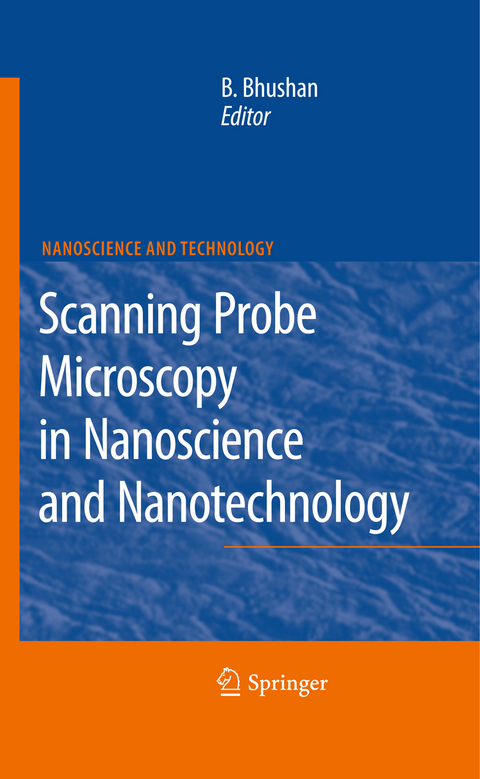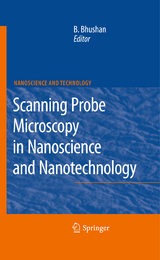Scanning Probe Microscopy in Nanoscience and Nanotechnology
Springer Berlin (Verlag)
978-3-642-03534-0 (ISBN)
This book presents the physical and technical foundation of the state of the art in applied scanning probe techniques. It constitutes a timely and comprehensive overview of SPM applications. The chapters in this volume relate to scanning probe microscopy techniques, characterization of various materials and structures and typical industrial applications, including topographic and dynamical surface studies of thin-film semiconductors, polymers, paper, ceramics, and magnetic and biological materials. The chapters are written by leading researchers and application scientists from all over the world and from various industries to provide a broader perspective. With a foreword by the co-inventor of AFM, Christoph Gerber
Dr. Bharat Bhushan received an M.S. in mechanical engineering from the Massachusetts Institute of Technology in 1971, an M.S. in mechanics and a Ph.D. in mechanical engineering from the University of Colorado at Boulder in 1973 and 1976, respectively, an MBA from Rensselaer Polytechnic Institute at Troy, NY in 1980, Doctor Technicae from the University of Trondheim at Trondheim, Norway in 1990, a Doctor of Technical Sciences from the Warsaw University of Technology at Warsaw, Poland in 1996, and Doctor Honoris Causa from the Metal-Polymer Research Institute of National Academy of Sciences at Gomel, Belarus in 2000. He is a registered professional engineer (mechanical) and presently an Ohio Eminent Scholar and The Howard D. Winbigler Professor in the Department of Mechanical Engineering, Graduate Research Faculty Advisor in the Department of Materials Science and Engineering, and the Director of the Nanotribology Laboratory for Information Storage & MEMS/NEMS (NLIM) at the Ohio State University, Columbus, Ohio. He is an internationally recognized expert of tribology on the macro- to nanoscales, and is one of the most prolific authors in the field. He is considered by some a pioneer of the tribology and mechanics of magnetic storage devices and a leading researcher in the fields of nanotribology and nanomechanics using scanning probe microscopy and applications to micro/nanotechnology.
Scanning Probe Microscopy Techniques.- Dynamic Force Microscopy and Spectroscopy Using the Frequency-Modulation Technique in Air and Liquids.- Photonic Force Microscopy: From Femtonewton Force Sensing to Ultra-Sensitive Spectroscopy.- Polarization-Sensitive Tip-Enhanced Raman Scattering.- Electrostatic Force Microscopy and Kelvin Force Microscopy as a Probe of the Electrostatic and Electronic Properties of Carbon Nanotubes.- Carbon Nanotube Atomic Force Microscopy with Applications to Biology and Electronics.- Novel Strategies to Probe the Fluid Properties and Revealing its Hidden Elasticity.- Combining Atomic Force Microscopy and Depth-Sensing Instruments for the Nanometer-Scale Mechanical Characterization of Soft Matter.- Static and Dynamic Structural Modeling Analysis of Atomic Force Microscope.- Experimental Methods for the Calibration of Lateral Forces in Atomic Force Microscopy.- Characterization.- Simultaneous Topography and Recognition Imaging.- Structural and Mechanical Mechanisms of Ocular Tissues Probed by AFM.- Force-Extension and Force-Clamp AFM Spectroscopies in Investigating Mechanochemical Reactions and Mechanical Properties of Single Biomolecules.- Multilevel Experimental and Modelling Techniques for Bioartificial Scaffolds and Matrices.- Quantized Mechanics of Nanotubes and Bundles.- Spin and Charge Pairing Instabilities in Nanoclusters and Nanomaterials.- Mechanical Properties of One-Dimensional Nanostructures.- Colossal Permittivity in Advanced Functional Heterogeneous Materials: The Relevance of the Local Measurements at Submicron Scale.- Controlling Wear on Nanoscale.- Contact Potential Difference Techniques as Probing Tools in Tribology and Surface Mapping.- Industrial Applications.- Modern Atomic Force Microscopy and Its Application to the Studyof Genome Architecture.- Near-Field Optical Litography.- A New AFM-Based Lithography Method: Thermochemical Nanolithography.- Scanning Probe Alloying Nanolithography.- Structuring the Surface of Crystallizable Polymers with an AFM Tip.- Application of Contact Mode AFM to Manufacturing Processes.- Scanning Probe Microscopy as a Tool Applied to Agriculture.
| Erscheint lt. Verlag | 5.3.2010 |
|---|---|
| Reihe/Serie | NanoScience and Technology |
| Zusatzinfo | XXX, 956 p. |
| Verlagsort | Berlin |
| Sprache | englisch |
| Maße | 155 x 235 mm |
| Gewicht | 1484 g |
| Themenwelt | Naturwissenschaften ► Physik / Astronomie ► Festkörperphysik |
| Naturwissenschaften ► Physik / Astronomie ► Thermodynamik | |
| Technik ► Maschinenbau | |
| Schlagworte | atomic force microscope • BioMEMS/NEMS • Biomimetics • Biosensor • biosensors • Carbon Nanotubes • Electronics • Industrie • Mechanics • Modeling • Nanomaterial • Nanoscience • nanostructure • nanotechnology • Scanning Probe Microscopy • Sensor • soft matter • Surface |
| ISBN-10 | 3-642-03534-5 / 3642035345 |
| ISBN-13 | 978-3-642-03534-0 / 9783642035340 |
| Zustand | Neuware |
| Haben Sie eine Frage zum Produkt? |
aus dem Bereich




